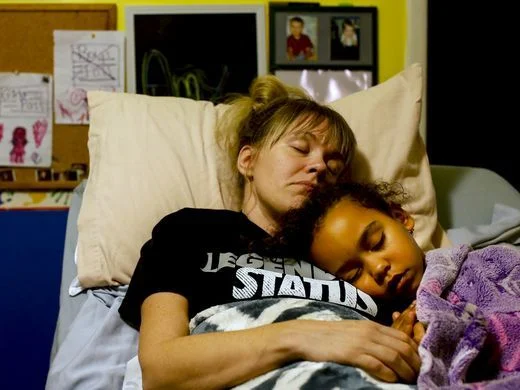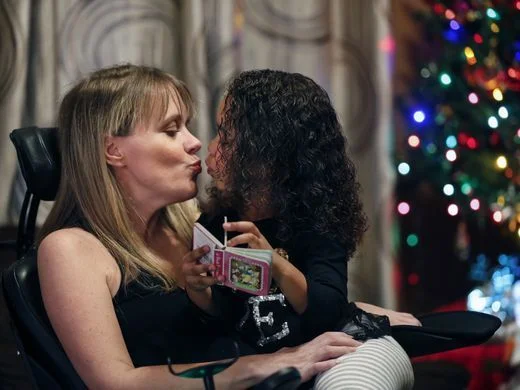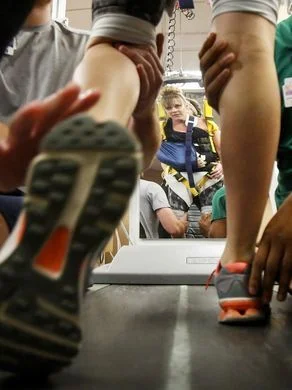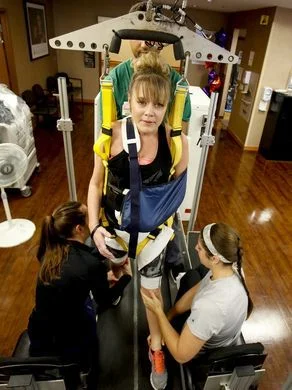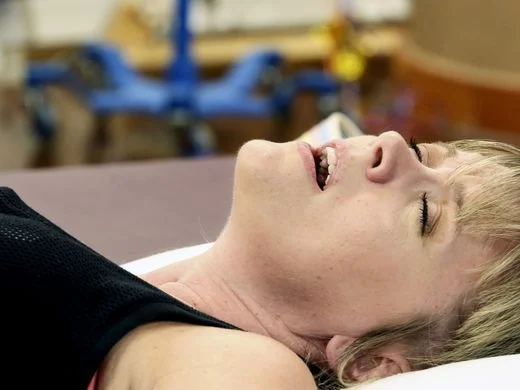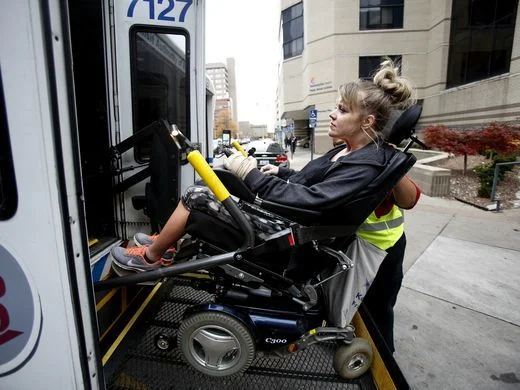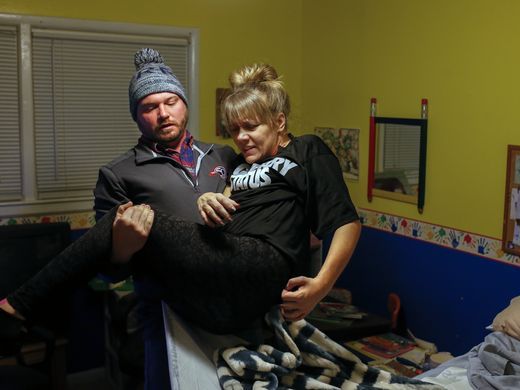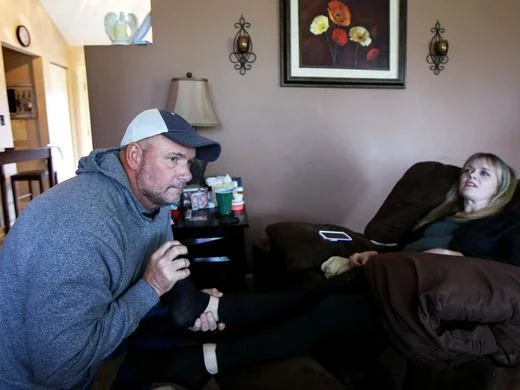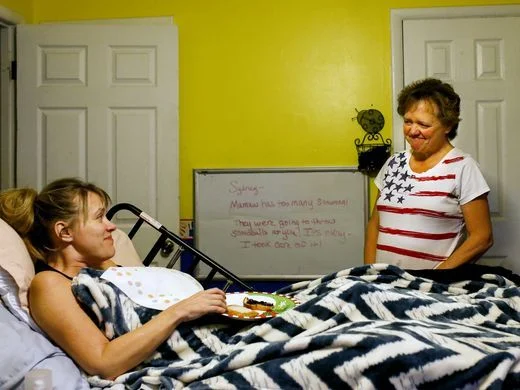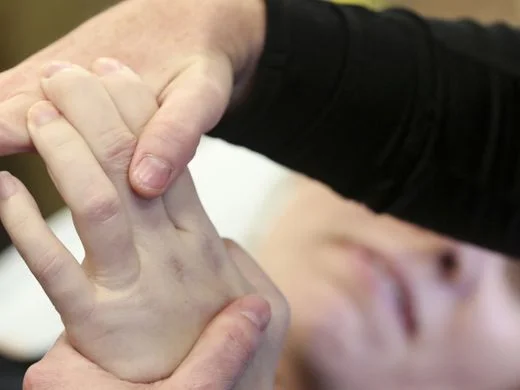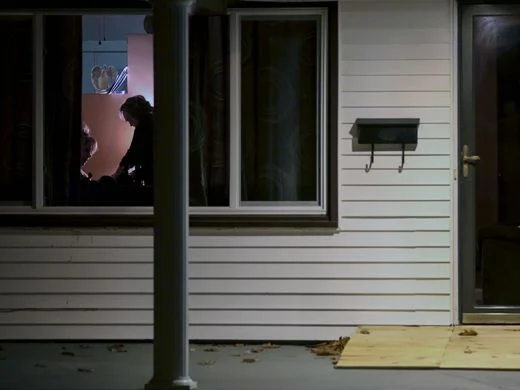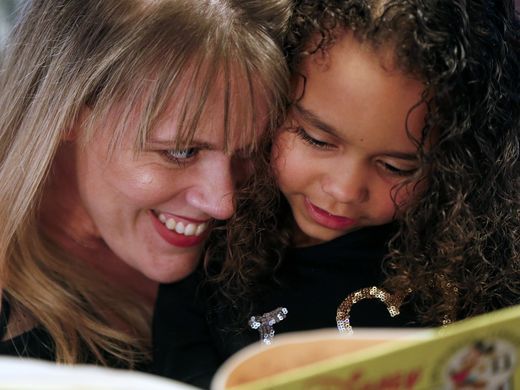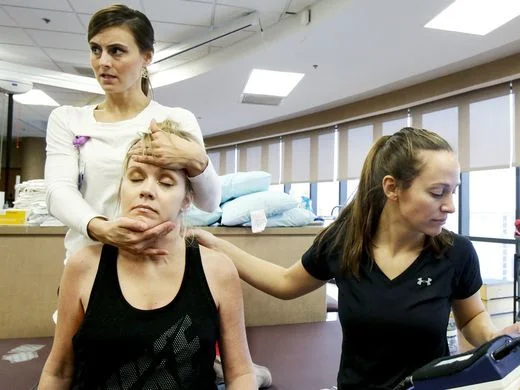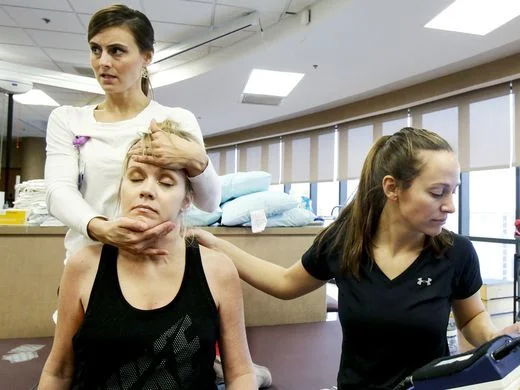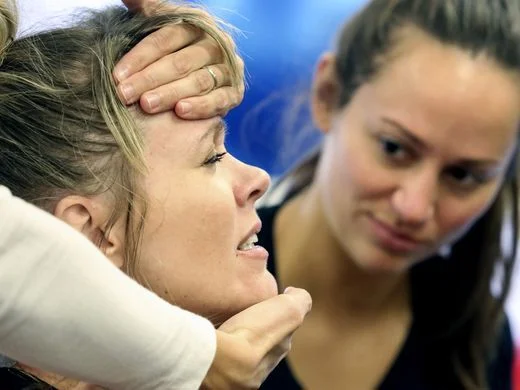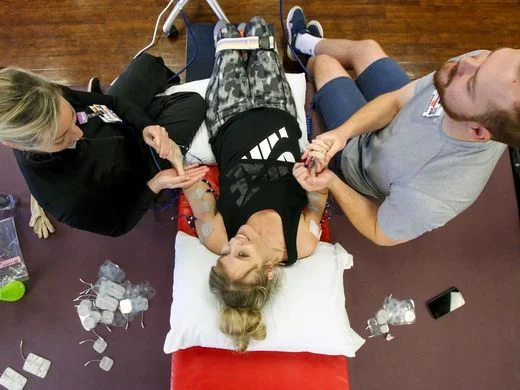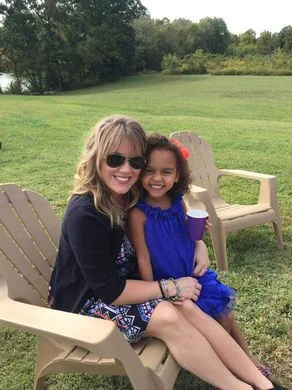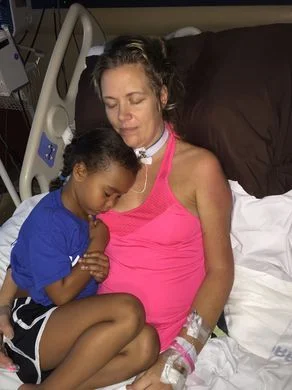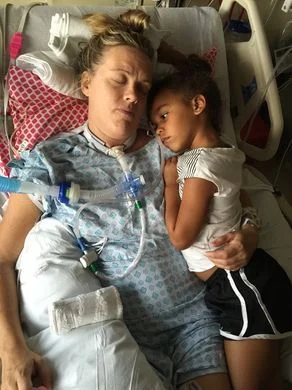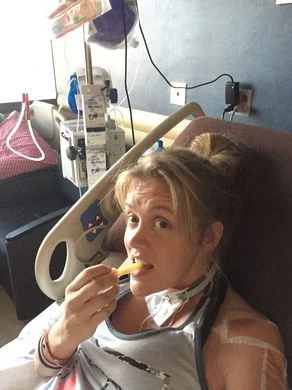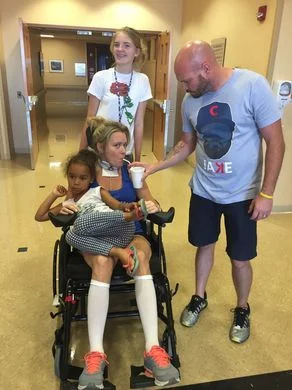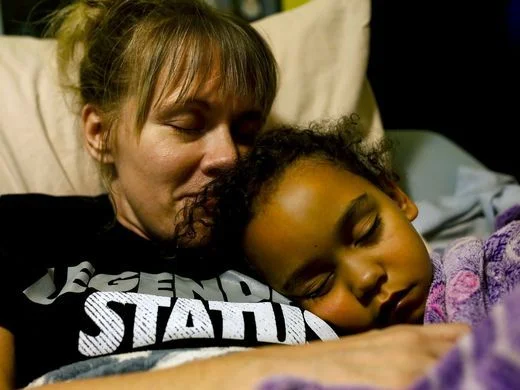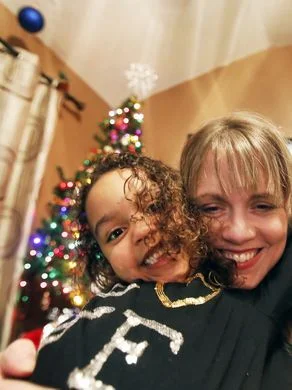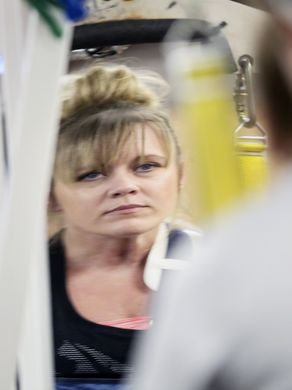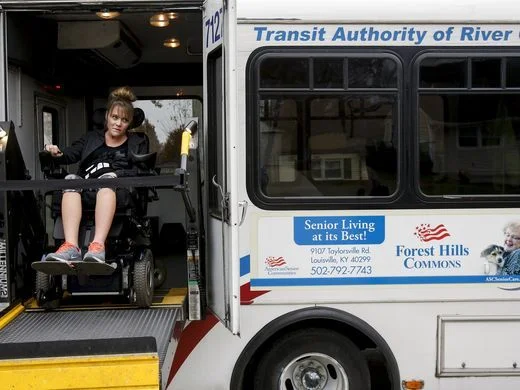Patient loses all but for the blink of an eye
Amy Bailey and her daughter Sydney cuddle in the early morning hours before Amy heads to physical therapy and Sydney goes to school.
On a hot July afternoon, Amy Bailey flipped on the TV to binge watch episodes of "Power" with a friend. It was her last afternoon to catch up on her favorite show and relax before she started a new job.
She’d felt dizzy all morning and sat at the edge of the bed to steady herself. Her body suddenly felt strange. Her left side grew heavy, then numb. Her left arm curled on its own toward her side. And her tongue bulged — big and fat — in her mouth.
Amy couldn’t talk. She wasn’t in pain, but as hard as she tried she couldn’t move. She felt trapped in her own body. Unable to hold herself up, she flopped backward onto the mattress.
"What the hell is going on?" she thought.
Amy saw her friend’s face, frantic and streaked with tears above her. She heard him dial 911 and shout to the operator: “Hurry up! Get here! I don’t know what’s going on with her. She’s not answering my questions.”
And then to her: “Stay with me. Don’t close your eyes. Stay with me.”
Then Amy felt his finger in her mouth. He didn’t want her to choke on her own swelling tongue.
Amy’s mother, Gina Anglin, sped to the emergency room at Norton Women’s and Children’s Hospital in St. Matthews. Suddenly, an alarm on one of the monitors went off in the exam room, and Amy scrunched her eyes in pain. Her thick tongue protruded from her mouth and hung there. She fell unconscious.
Doctors rushed in and soon after brought family members to the quiet room. There was nothing more they could do for her.
Amy had suffered a stroke, and it was time to say goodbye.
At 39, Amy Bailey would die.
Amy Bailey and her daughter Sydney take a break from reading for a kiss.
“I would call her a miracle,” he said.
In May, after seven years of marriage and months of marital counseling, Amy and her husband, Chris Bailey, separated. She found herself a cute apartment.
About a month after she took the keys, she was moving a speaker and forgot she was under a spiral staircase. She stood straight up and whacked the top of her head — hard. That night she worried she might have a concussion. Then two weeks later, her neck began to ache. She tried massages, hot and cold compresses, Biofreeze. Nothing worked.
By July 8, sharp pains shot up the right side of her head, around the curve of her ear. Maybe it was a pinched nerve, she thought. But her mom was adamant.
“You cannot play around with this stuff,” Amy remembered her mother saying. “Your Aunt Becky was 40 when she had a stroke and died. So get to the doctor, and I mean it.”
Amy went, but the doctor found nothing. An X-ray showed no broken bones. He scheduled an MRI for Aug. 5.
But Amy didn’t make it that long.
Amy Bailey, with the help of physical therapists and a harness, works out on a treadmill five days a week.
On July 20, she was in the shower and felt so dizzy she didn’t finish rinsing her hair. Her words were slurred so a friend took her to the emergency room. But ER doctors diagnosed her with a complicated migraine and sent her home, she said.
The next afternoon, July 21, Amy collapsed on her bed.
Doctors say that when she hit her head, it likely caused a small tear in her vertebral artery. The blood pooled, causing a clot to form that then dislodged. And though the stroke was small — and exceedingly rare for a bump on the head — it centered in the lower part of the brain stem, in the medulla. The medulla is only about the size of a peanut, but it controls breathing, heart rate, motor skills and the ability to sense touch — the very essence of life. The mortality rate for this type of stroke is upward of 80 percent.
After doctors at Norton gave Amy's family the diagnosis, they moved her to ICU.
Over the next 24 hours, she heard snippets of conversations and saw flashes of people. Her mother crying hysterically and pacing the floor. Her husband standing over her, saying I love you.
"Why would he be saying that? We’re going through a divorce."
There was a minister, too — not hers — coming in to pray.
Then she realized: She was dying.
In her mind, Amy was shaking her head, no. In her mind, she was waving her left hand to dismiss the chaplain. But all she could do was blink. No minister was going to pray for her soul to get to heaven. She was not dying. She blinked as hard as she could. No.
As Amy became more alert, she had that familiar look, the one family and friends teased her about. The one that betrayed her mood simply with her eyes. So Amy’s friend, Meghan Starr, who’d always been more like a sister, got in her face.
"Can you understand me?" Meghan asked.
Amy blinked hard.
So Meghan instructed: A hard blink means no. Slow, soft blinks mean yes.
Do you realize you’ve had a stroke? Slow, soft blinks.
Are you cold? Hot? Do you hurt? Meghan ticked off a list of immediate needs. But she could tell Amy wanted to talk.
“I said, ‘OK, we’re going to do this blinking thing with the alphabet,” Meghan said.
Meghan slowly recited the alphabet. A-B-C-D-E-F-G until she reached the letter Amy wanted. It took more than 10 minutes for the two to form a simple sentence.
A-M -I- D-Y-I-N-G?
Meghan composed herself as best she could.
“No, you’re not, sweetheart,” she said. “You’ve had a stroke.”
Meghan explained what Locked-In Syndrome meant. It was the reason she couldn’t move.
Amy’s next question took longer to form and was tougher to answer:
How long will I be this way?
Meghan picked a number. “Six months,” she said.
She could see the tears coming.
“No, no, no, no, no,” Meghan told her. “Six months is not a long time. I promise you. It’s not a long time. It will go by quickly.”
A year before the stroke, Amy made big changes in her life, Meghan said. She got spiritually and physically fit. She had a strong relationship with God. So she knew what Amy was thinking.
“I know you want to know why,” Meghan told her. “But you’re not gonna know why right now. But there will come a time when this will make sense. It’s just not gonna be right now. We just have to get through it one day at a time.”
That night, when everyone else was in the waiting room, exhausted, defeated, Meghan sat alone at Amy's bedside, rubbing her back. Suddenly, Amy moved her left arm.
"Did you do that on purpose?" Meghan asked.
Amy blinked yes. Meghan asked her to do it again, and Amy did. Meghan rushed to the waiting room to tell Amy's family, and they raced to see for themselves. She moved her left arm a third time on command.
Then, over the next few days, Amy moved ever so slightly when they asked, though not every time, her family said. She blinked L-I-F-T with her eyes and raised her leg about three inches. She wiggled her toes.
But doctors insisted those movements were muscle spasms, her mom, Gina, said. Family members needed to accept her fate: Amy would live the rest of her life in a nursing home.
“You don’t know my daughter,” Gina railed at one neurologist. “She’s a fighter. She’ll pull through this. And he just looked at me like I was crazy. And he said, ‘Miracles happen.’ And I said, ‘OK, if that’s what you think, then it’s gonna be a miracle.’”
Because Amy will.
Amy was in the hospital three days before she saw her daughter, Sydney. She was still hooked up to a ventilator. Her tongue still hung out of her mouth. She couldn’t move.
But the first thing the 5-year-old wanted was to give her mommy “heart kisses,” something she’d done since she was a toddler. So Amy’s mom maneuvered the tubes out of the way so Sydney could kiss her mother’s chest just below the notch at the base of her neck.
Sydney wasn’t scared. She didn’t cry. She wanted to cuddle. So she climbed in the hospital bed, and family members wrapped Amy’s arms around her. And while the visit buoyed Amy’s spirits, she wasn’t getting better.
She developed double pneumonia and a staph infection. Her family worried that without more aggressive treatment she would die. They wanted her moved to the stroke center at the University of Louisville Hospital. So Amy gave Meghan power of attorney. A witness confirmed for a lawyer that Amy blinked yes. Amy knew if anyone could do it, her best friend would fight like a pit bull to get it done.
On July 26, an ambulance took Amy to U of L where Dr. Shah awaited.
Dr. Shah rubbed prickly instruments on Amy’s skin. He pressed her thumbnails and toenails. She winced. Amy could feel from her scalp to her feet.
“It made me feel so much better to have a doctor that actually believed she could be treated,” Amy’s mom remembered.
Another milestone.
But physicians were honest about her chances. They never promised. Yet her family believed.
Amy will.
In that week at U of L Hospital, Amy was never alone. Her brother Chad Anglin managed a calendar of friends and family who took four-hour shifts around the clock to tend to her.
Progress was slow. Nurses pulled back oxygen on the ventilator to see if Amy’s lungs could hold their own. They weaned her more each day. Some days her lungs were stronger; other days the machine did more of the work.
Her bright spot was always Sydney.
“When she was comfortable enough that Sydney could climb in bed with her, she would always ask us, ‘Wrap my arms around her. Wrap my arms around her,’” her brother Chad said. “So we would physically have to wrap Amy’s arms around her so Sydney could feel the love and Amy could as well.”
The goal: Get to Frazier Rehab Institute for intense inpatient therapy. But Amy had to be off the ventilator 72 hours before she could go.
“We just prayed and prayed and prayed for her to get into Frazier,” Meghan said.
Amy was off the vent for a day but had a panic attack and had to go back on it, so she missed the open bed.
She had to go to Kindred Hospital to wean off the ventilator again and wait for another open spot at Frazier.
That setback put Amy into a tailspin. She was in a dark place, depressed. She still wasn’t talking, wasn’t moving. She heard other patients in the hallway moan help me. She couldn’t tell the aide that her mouth was full of mucous and needed to be sucked out. She couldn’t hug her daughter. She knew she couldn’t stay there. Couldn’t live that way.
One afternoon, Amy looked at her mom with those same eyes.
Gina knew what she was going to say.
“Don’t do it,” her mother said. “Don’t do it.”
Amy blinked the letters: I-W-A-N-T-T-O-D-I-E.
She had no quality of life. She didn’t want to burden her family. She worried whether her young daughter would feel obligated to visit her. She didn’t want Sydney to see her like that.
Amy failed multiple swallow tests so she had to be fed through a tube. The liquid nutrition cramped her stomach and gave her diarrhea. She begged friends to sneak her sips of water.
But family members had been reading aloud to her a story about a woman named Kate Allatt, a 39-year-old who was diagnosed with Locked-In Syndrome after a brain stem stroke. The woman recovered in less than a year.
Hearing the story, something in Amy changed. The fighter took over.
"Who the hell do they think they are to tell me that I have Locked-In Syndrome?" Amy thought. "This is the same story. And I’m not giving up. If somebody tells me I can’t do something, I want to prove them wrong."
She would walk again. She wouldn't leave her daughter alone in this world.
It’s what her family had been telling doctors all along.
Amy will.
Family members massaged her legs, curled her arms, flexed her feet.
Every time doctors delivered bad news, Amy’s church members got down on their knees. They made a special effort with 21 days of prayer at her bedside.
“Somebody would come in and say, ‘Just get used to it,’” Pastor Randy Hollis of Believers Church in Okolona said. “‘This is as good as it’s going to get.’ And they were told pretty quickly, as kind as anyone knew how, ‘You don’t know Amy.’ And then those of us that were standing with her prayerfully, ‘You don’t know God.’”
On Aug. 22, Amy hit another milestone when an inpatient bed opened at Frazier.
The next goal was rigorous physical, occupational and speech therapy.
Within days, Amy hit another milestone. Doctors plugged her trach, and for the first time since the day of the stroke, she heard her own voice again.
Hello…
Her voice was raspy, breathy. It didn’t sound like her old self. She didn’t like it. But she could finally talk about what she remembered the day of the stroke, the terrible ambulance ride, and the exasperating moments of trying to spell something when the person listening forgot the previous letters.
It was more proof to Amy’s family that she would defy the odds. Other patients who have brain stem strokes never talk again.
But Amy will.
By Sept. 1, physical therapists had Amy standing in a harness so her feet touched the ground. She still couldn’t hold her head up on her own. Her chin slumped to her chest like a newborn baby’s because the muscles were so weak.
“Frazier changed her,” Meghan said. “Her whole spirit, mind, everything changed. She was so happy. The glow on her face was different. She just was so hopeful. She would tell people: ‘I know I’m gonna get better. I know I’m gonna walk again.’”
Amy finally passed a swallow test so the feeding tube she hated so much came out.
During one of Amy's early days at Frazier, Meghan asked what she needed, and Amy spelled cheese enchilada. It became an inside joke. So when the feeding tube came out, her speech therapist brought homemade chicken enchiladas for her first real meal.
Another milestone. Another reason to celebrate. Another moment of faith made manifest.
During Amy’s last week as an in-patient at Frazier, Meghan got to watch her best friend pick up a cup with her right hand and bring it to her lips. She saw Amy dip a spoon into a bowl of cereal and take a bite. She had just enough dexterity to text. All on her own.
The family mantra, the social media hashtag became more important than ever. It helped people believe.
Amy. Will.
But moving into her mom and dad’s house was a reality check. Her bed replaced the pool table in her parents’ game room.
The woman who had a high-stress sales job, an active social life, who worked out five days a week before the stroke, needed help with everything. Her brothers Chad and Tim carried her from the recliner to her bed. Her mom helped her use a bedpan. She couldn’t dress herself. Her dad, Stan Anglin, maneuvered pillows to make her more comfortable. Her sisters-in-law got in the shower with Amy to bathe her.
“I kind of lost track of praying,” Amy said. "I don’t want to say I was sulking, but I was like, ‘Why is my life like this?’ Then I remembered I have to have my faith. I can’t let it waiver.”
Physical therapists were able to get Amy onto the 11th floor at Frazier, the spinal cord floor, for intense five-days-a-week physical and occupational therapy. She’s been at it for about 25 sessions now. Doctors hope insurance will approve up to 80 sessions because research shows stroke patients can make significant improvements for up to a year.
Chad Anglin comes over every morning to carry his sister Amy from her bed to a hospital bed and then returns a little later to carry her from the hospital bed to her wheelchair.
Five days a week, Amy wakes up at 5 a.m. so her brother Chad can move her from her own bed to a hospital bed. It’s easier for Gina to dress her for physical therapy. He comes back at 6:30 a.m. to put her in her wheelchair. She then boards the TARC bus in the dark for the long ride down Dixie Highway toward Frazier.
For the first hour, she’s strapped into a harness with her feet on a moving treadmill. She holds a good deal of her own body weight. A machine takes care of the rest. Physical therapists bend her knees and scoop her ankles to retrain the body to understand what it feels like to walk again. Amy initiates the movement herself, and the trainers help her the rest of the way.
For the next hour, an occupational therapist attaches electrodes up and down her arms to stimulate her muscles. As the machine sends out a charge, Amy squeezes or extends her hand, and the therapist moves it the full distance. It’s tedious but important work because research shows the more repetition, the better the progress.
And at least two days a week, Amy sits with a speech therapist to work on her breath. The exercises are monotonous and the most frustrating because for Amy it seems her voice should come naturally. She breathes in and out, holding certain sounds for a specific count. She holds ssssss the way a toddler learns what a snake says. Z’s are hard because they take both breath and her vocal cords. She’s made progress on volume. Though her aaaaahhhh — like the noise a patient makes when a doctor uses a tongue depressor to look at tonsils — is muffled. It sounds a bit like a deaf person’s speech. And she still has trouble correctly saying the letter R.
Still, there are small milestones. Every day.
Sydney reads to her mom Amy Bailey on a Saturday evening.
Amy still can’t move on her own from the motorized wheelchair to the toilet or recliner, but she can help the person moving her. She has significant use of her right arm. She can brush her teeth, feed herself and hug Sydney. She can kick her left leg out but not as high as her right leg. She can initiate more movement in her left hand. She can hold more of her own body weight in the treadmill harness. And her physical therapist can feel when Amy initiates her quad muscles when she practices squats.
Amy’s doctors and therapists won’t predict how much she’ll recover, but they see signs of progress. Her young age helps because she has more neuroplasticity — the brain’s ability to reorganize itself by forming new neural connections after an injury. Her attitude also matters. Dr. Shah says simply thinking about moving her left side activates the neurons in Amy’s brain.
“The ultimate end game of that is very hard to predict,” said Dr. Matthew Adamkin, Amy’s physical medicine and rehabilitation doctor. “Somebody that’s just meeting Amy for the first time right now would feel that she can do relatively little.”
But for those who’ve followed her journey, the change is remarkable, he said.
“And I think she will continue to go down that path.”
These days, Amy doesn’t go anywhere except physical therapy because, even though the TARC bus will take her, friends’ and family members’ houses don’t have ramps. And she still feels a bit self-conscious about how she looks. She missed her daughter’s first day of kindergarten and breakfast with Santa.
Yet most days, Amy is positive. The stroke has been hard, but it hasn’t been in vain. People in her family who weren’t talking to each other are now. She has a close relationship with her husband, Chris Bailey, despite their impending divorce. He brings her bowls of chili — a favorite — when he visits, and they exchange I-love-you’s when they say goodbye.
“The number of people in my family, outside my family, that it’s helped in some way shape or form — whether that’s a relationship with God or a relationship with someone they didn’t necessarily have a relationship with — it’s made them realize life is too short,” Amy said.
“I mean here I am, I’m 39. So active. Active in my kid’s life. I’m going to the gym. I’m working out. I’m eating healthy. And bam, I have a stroke. And I’m literally on my deathbed.”
She believes there’s a reason she’s still alive.
“If God needs to use me — you know that saying he gives his toughest battles to his strongest soldiers — I’m flattered,” she said.
It will take an unwavering resolve and God’s grace, but Amy believes she’ll walk again.
In fact, she insists on it. If anyone asks, her answer is simple.
I will.
Originally published in the Courier Journal | Images by Scott Utterback

